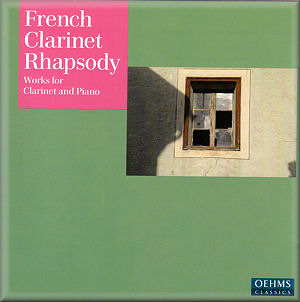 |
 |
|


alternatively
CD: MDT
Sound
Samples & Downloads
|
French Clarinet Rhapsody
Claude DEBUSSY (1862-1918)
Première rhapsodie (1910) [9:09]
Petite pièce (1910) [1:45]
Francis POULENC (1899-1963)
Sonata for Clarinet and Piano (1865) [14:02]
Arthur HONEGGER (1892-1955)
Sonatina for Clarinet and Piano, H.42 (1921-22) [5:54]
Florent SCHMITT (1870-1958)
Andantino Op.30 No.10 (1906) [3:38]
Darius MILHAUD (1892-1974)
Sonatina, Op.100 (1927) [9:48]
Duo Concertant, Op.351 (1956) [5:55]
Caprice, Op.335a (1954) [1:57]
 Ralph Manno (clarinet), Alfredo Perl (piano)
Ralph Manno (clarinet), Alfredo Perl (piano)
rec. April 1995, Sendesaal Radio Bremen. DDD.
 OEHMS CLASSICS OC114 [53:38]
OEHMS CLASSICS OC114 [53:38] 
|
|
|
There are many clarinet-and-piano records. More often the clarinet
plays the leading role, the piano serving as a supporting background.
Less often they have equal input. On this disc, the piano does
more than we may be used to. And the clarinet does less. It
is a strange feeling - that the clarinet is a nuisance. But
at some moments that was exactly the feeling I had with this
recital disc. It seemed that Alfredo Perl did all the emotional
work, and Ralph Manno was a skilful but indifferent accompanist.
OK, there is beauty and sentiment there, and virtuosity is undeniable.
Still, I was left with the feeling that the clarinet lacks the
will to step forward, to show emotion. By contrast the piano
is exceptionally colorful. Maybe it’s the difference between
the musicians’ German and Chilean temperaments.
The program is well conceived. The disc opens with the exotic
jungle of the Première rhapsodie. It is less dynamic
and more languid than usual - kind of Afternoon of a Clarinet.
It is not really slow, but somehow the notes seem longer. The
main motif especially slows down. The episodes of brisk movement
have a lot of character, but Manno does not make the long notes
interesting. In other performances we may not even notice these
notes behind the music: here we hear them very distinctly: Note.
Note. Note. Like horizontal shelves. Perl, on the other hand,
is excellent in the role of the orchestra: fluid, diverse, multi-colored.
The ensuing Petite pièce is light and soft.
Perl is also admirable in Poulenc’s beautiful Sonata,
one of the gems of the chamber music. Each piano note seems
hand-painted. The first movement is faster and sharper than
usual. The slow movement is not very calm, as the composer’s
mark requests. Rather, it is emotional. The clarinet does not
hush its voice. Manno is shrill in the third movement, which
starts to remind the Chinese Dance from The Nutcracker.
The word “sonatina” is often associated with simplified
fast-slow-fast structure and Haydnesque carefree mood. Honegger’s
Sonatine is dark and pensive - until the finale, which
bursts with French optimism and reminds us that Honegger also
wrote Pacific 231. This finale is played very well -
alive and kicking. However, the first movement is too quiet,
the clarinet almost expressionless. I don’t feel that
the soul of this music is there.
Schmitt’s Andantino began its life as a vocalise.
I do not know the original soprano version, but I imagine that
it makes more sense than the clarinet arrangement or, perhaps
the performance needs more emotion to get the listener involved.
Milhaud’s heavily polytonal Sonatine frames a song-like
middle movement with two fast parts, very similar to each other
and marked very rude. These two are quite untamed, with
childish “merry violence”, wild rhythms and abstract
harmonies. The performance is very good. In the first movement
we get some quieter corners to look around. The slow movement
shows impressive, albeit disturbing, views. The finale is hectic
and full of excitement. The Duo concertant is in ABA
form, where A is a carefree polka, while B is calm and pastoral.
Again, Manno and Perl are very good: the middle section is lively
and atmospheric; the outer sections are light and bouncy. Finally,
Caprice is a good-humored sketch, in the mood of a happy
walking. The performance is fast, but not too much: alive, not
hasty.
The recording is clear, but not especially deep. The liner-note
is not very informative. The total playing time of the disc
can’t be called generous. All things considered, this
is not a must-have though the Milhaud is good. The emotionally
detached approach of Ralph Manno does not suit this repertoire
perfectly. Alfredo Perl does a really great job, but in clarinet
pieces one would expect first of all to listen to the clarinet.
Oleg Ledeniov
|
|

